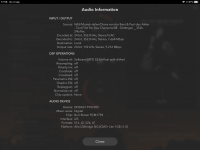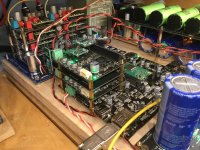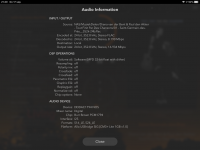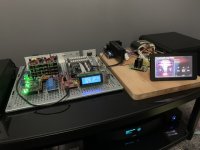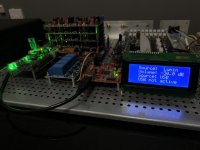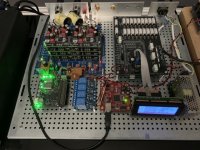Yes, my build is heavily tweaked.
I have Salas Shunt for analog, and ADM7150 for digital.
Choke filtered supply, Salas powered buffer and so on...
Waiting for Andrea's clock for my Cronus-BBB that outputs directly right justified data, without the mainboard processing.
I have Salas Shunt for analog, and ADM7150 for digital.
Choke filtered supply, Salas powered buffer and so on...
Waiting for Andrea's clock for my Cronus-BBB that outputs directly right justified data, without the mainboard processing.
The dddac is able to play files up to 384khz. Why does moode audio convert my 352khz files to 192khz?
I use an usbridge sig with I2S out to fifopi and to the dac stack and the latest moode software.
I use an usbridge sig with I2S out to fifopi and to the dac stack and the latest moode software.
Attachments
The dddac is able to play files up to 384khz. Why does moode audio convert my 352khz files to 192khz?
I use an usbridge sig with I2S out to fifopi and to the dac stack and the latest moode software.
@Supersurfer: A fellow moOde user!
The software that handles the audio with the moOde distro is MPD.
Assuming you have a stock 6.7.1 distro without mods.
Because the outputrate differs from the decoded rate, the output device has informed MPD that samplerate isn't supported. Thats why MPD downsamples.
First place to check is what the command alsacap tells about the device capabilities.
This will go very fast very OT, maybe an idea to move the question to Moode Forum ? moOde has a very active community.
Based on @Supersurfer issue I have created a patch for the stock raspberry pi linux kernel that will support 384k for rpi-dac driver. And yes it works fine:
 .
.
The kernels guys now only say that according spec it only goes to 192kHz, only that is with the 8x oversampling and filter active.
Does anyone have for me a reference that it 38k4 is indeed supported and that I'm not misusing the pcm1794a ?
Or can help me with the discussion at github ?
Thanks
Marcel

The kernels guys now only say that according spec it only goes to 192kHz, only that is with the 8x oversampling and filter active.
Does anyone have for me a reference that it 38k4 is indeed supported and that I'm not misusing the pcm1794a ?
Or can help me with the discussion at github ?
Thanks
Marcel
Hello,
As a long time DDDAC user i try people to get one too.
Recently i was asked by someone here for some help to use a high current choke in a '' Le Monstre '' solid state amp which has an input impedance around 47Kohm.
He told me he wanna build a TDA1541 dac with an added tube output stage( which will have the function of volume control too) he is not a very experienced diy person and the dac he wants to make will pose a lot of questions.
I told him to get a DDDAC ( I came from a Curcio tube dac) and make sure it wont have any DC on its output because it will be the end of Le Monstre.
Using an output cap and a pot will function but it wont be that good.
Audio Creative just introduced a new output 600/600 ohm output transformer for the DDDAC. What about connecting that one to a traditional potmeter or an AVC ( Dave Slagle)
You will need a cap or a transformer because just an AVC will not stop dc.
Most transformer based ( with prim and sec. side) volume controls have to be adapted to be used with the DDDAC.
Hope to get some information that will convince someone in Brazil to get a DDDAC too.
By the way the new transformer will also need a 4 board DDDAC?
Greetings, eduard
As a long time DDDAC user i try people to get one too.
Recently i was asked by someone here for some help to use a high current choke in a '' Le Monstre '' solid state amp which has an input impedance around 47Kohm.
He told me he wanna build a TDA1541 dac with an added tube output stage( which will have the function of volume control too) he is not a very experienced diy person and the dac he wants to make will pose a lot of questions.
I told him to get a DDDAC ( I came from a Curcio tube dac) and make sure it wont have any DC on its output because it will be the end of Le Monstre.
Using an output cap and a pot will function but it wont be that good.
Audio Creative just introduced a new output 600/600 ohm output transformer for the DDDAC. What about connecting that one to a traditional potmeter or an AVC ( Dave Slagle)
You will need a cap or a transformer because just an AVC will not stop dc.
Most transformer based ( with prim and sec. side) volume controls have to be adapted to be used with the DDDAC.
Hope to get some information that will convince someone in Brazil to get a DDDAC too.
By the way the new transformer will also need a 4 board DDDAC?
Greetings, eduard
Hi Eduard,
I am using the audio creative trafo's with two deck dddac and like it very much, especially compared to the Neurochrome buffer I used before.
I am using the audio creative trafo's with two deck dddac and like it very much, especially compared to the Neurochrome buffer I used before.
Hello Robin,
So the your output transformers dont need 4 decks to make them work perfect.
Of course more decks will improve the sound but if technically 2 decks are enough one could spend money on something that will give a higher return on investment.
From 1 to 2 and from 2 to 4 are both nice investment i guess. I started right away with 4 and Doedes Sowter and choke input but jumping to 8 will need other chokes too so for now i wanna make changes in additional gear closely related to the DDDAC
You are using a symmetrical output?
But what are you using as volume control, just a pot or an active pre amp.
The DDDAC has output enough to drive a Le Monstre.
I told my brazilian audio friend to invest in the right '' interface'' between DDAC and power amp. It could be a little more expensive but in the end it might be cheaper . No need to look for new tubes.
Greetings, eduard
So the your output transformers dont need 4 decks to make them work perfect.
Of course more decks will improve the sound but if technically 2 decks are enough one could spend money on something that will give a higher return on investment.
From 1 to 2 and from 2 to 4 are both nice investment i guess. I started right away with 4 and Doedes Sowter and choke input but jumping to 8 will need other chokes too so for now i wanna make changes in additional gear closely related to the DDDAC
You are using a symmetrical output?
But what are you using as volume control, just a pot or an active pre amp.
The DDDAC has output enough to drive a Le Monstre.
I told my brazilian audio friend to invest in the right '' interface'' between DDAC and power amp. It could be a little more expensive but in the end it might be cheaper . No need to look for new tubes.
Greetings, eduard
Take a look at TVCs as volume control and output transformer for the DDDAC. The Sowter 9335 are good.
Transformers and decks
I believe there is still some need for clarification on number of decks and transformers.
Key for transformers and their low frequency -3dB roll off point is the simple formula of Induction of the primary and the output resistance of the source
Fc = ( Rs / Lp ) / 6.28
want to play with filter values? here is a great site:
filter web site with online calculator and graphs
example: Source is 600 Ohm and induction is 10H -> Fc(-3dB) = ~10Hz
Now standard of the shelf transformers must be able to be used by a wide variety of sources, hence the primary winding has a high induction. The con is less bandwidth and other losses and the less fit for DC offset
so for most standard transformers the output impedance of one deck (266 Ohm) should be sufficient for most
For the special case of the DDDAC Sowter this was designed by Brian Sowter to be able to absorb some DC offset (which the DAC has) like less windings is "better" - also MU metal case etc , but the less winding´s was key. Hence the induction is low. leading to a good HF response as well, but now with the con side that the you need a low output impedance. the induction is like 0,7H (where the standard ones are more like 10H or more)
with one deck this will lead to a Fc of ~ 60Hz
so with 4 decks this will be 15 Hz, hence the recommendation to use 4 decks with the special DDDAC Sowter
for standard transformers this is not necessary in most of the cases
hope this helps a bit
I believe there is still some need for clarification on number of decks and transformers.
Key for transformers and their low frequency -3dB roll off point is the simple formula of Induction of the primary and the output resistance of the source
Fc = ( Rs / Lp ) / 6.28
want to play with filter values? here is a great site:
filter web site with online calculator and graphs
example: Source is 600 Ohm and induction is 10H -> Fc(-3dB) = ~10Hz
Now standard of the shelf transformers must be able to be used by a wide variety of sources, hence the primary winding has a high induction. The con is less bandwidth and other losses and the less fit for DC offset
so for most standard transformers the output impedance of one deck (266 Ohm) should be sufficient for most
For the special case of the DDDAC Sowter this was designed by Brian Sowter to be able to absorb some DC offset (which the DAC has) like less windings is "better" - also MU metal case etc , but the less winding´s was key. Hence the induction is low. leading to a good HF response as well, but now with the con side that the you need a low output impedance. the induction is like 0,7H (where the standard ones are more like 10H or more)
with one deck this will lead to a Fc of ~ 60Hz
so with 4 decks this will be 15 Hz, hence the recommendation to use 4 decks with the special DDDAC Sowter
for standard transformers this is not necessary in most of the cases
hope this helps a bit
Don't you also need to factor in the primary resistance of the transformer?
For example with Sowter 9335 (404 Not Found
- Output impedance of 1 x DAC board: R0 = 266 Ohm
- Primary resistance of Sowter 9335: Rp = 310 Ohm
- Primary inductance of Sowter 9335: Lp = 85 H
==> cut-off frequency fc = (R0+Rp) / Lp / (2pi) = 1.1 Hz
For example with Sowter 9335 (404 Not Found
- Output impedance of 1 x DAC board: R0 = 266 Ohm
- Primary resistance of Sowter 9335: Rp = 310 Ohm
- Primary inductance of Sowter 9335: Lp = 85 H
==> cut-off frequency fc = (R0+Rp) / Lp / (2pi) = 1.1 Hz
yes you should do that for a more accurate outcome of the calculation
I probably ignored it, to keep it basic and as "my" Sowters have only 2 Ohm.
And for the "shelf" ones, it does not matter as the induction is high enough anyway.
I did not want to make it straight from the book, just give some general insight. But basically you are 100% correct 😎
I probably ignored it, to keep it basic and as "my" Sowters have only 2 Ohm.
And for the "shelf" ones, it does not matter as the induction is high enough anyway.
I did not want to make it straight from the book, just give some general insight. But basically you are 100% correct 😎
The dddac is able to play files up to 384khz. Why does moode audio convert my 352khz files to 192khz?
I use an usbridge sig with I2S out to fifopi and to the dac stack and the latest moode software.
Bitlab has made a patch to be able to play native files with a frequency rate higher than the current limit of 192khz and it is working nicely!
You can find the procedure and link to the patch file on his website: Raspberry as generic i2s master at 384kHz – Bitlab's Bytes
Attachments
Thank you Doede! Sounds super thank you but will be even better when those special transformers are here! Enjoying the journey 😀
by the way... anyone who has the opportunity to test/listen on the new Q3 FiFoPi using Tentlabs XO clocks (should work now because of no need for OE), compared with the Accusilicon, please post your experience?
thx!
thx!
That would be a very interesting comparison[emoji4]by the way... anyone who has the opportunity to test/listen on the new Q3 FiFoPi using Tentlabs XO clocks (should work now because of no need for OE), compared with the Accusilicon, please post your experience?
thx!
- Home
- Source & Line
- Digital Line Level
- A NOS 192/24 DAC with the PCM1794 (and WaveIO USB input)
